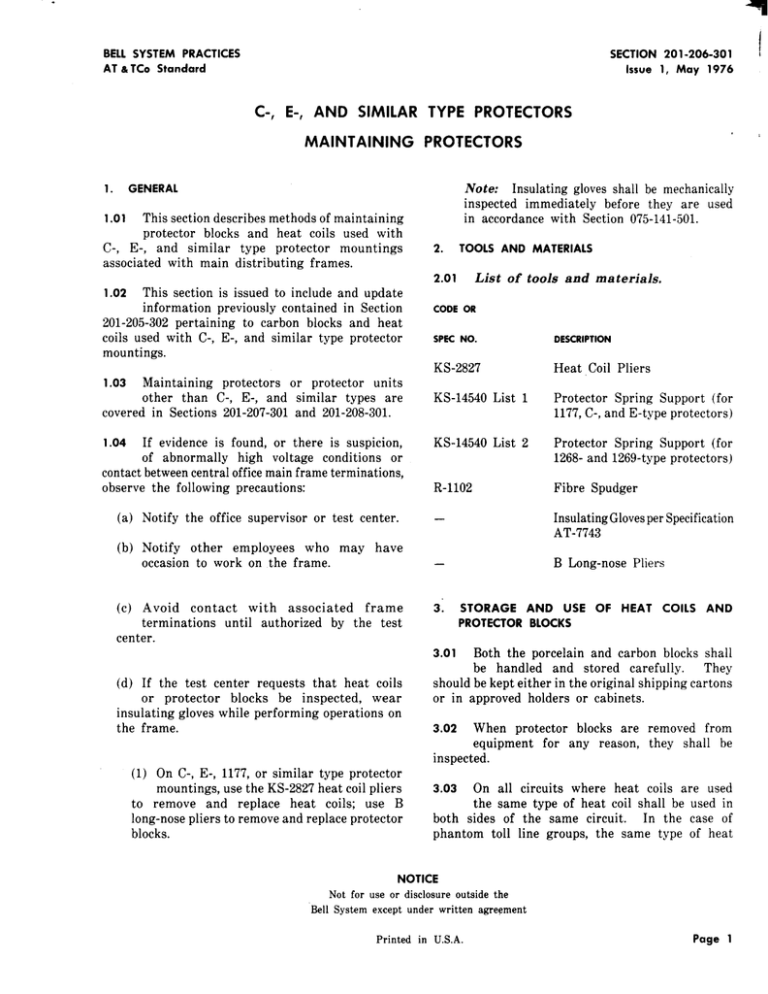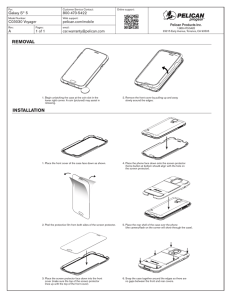Document
advertisement

I
BELL SYSTEM
PRACTICES
SECTION
AT & TCO Standard
201-206-301
Issue 1, May
C-, E-, AND
SIMILAR
TYPE
I
1976
PROTECTORS
,,
MAINTAINING
1.
PROTECTORS
iVote: Insulating gloves shall be mechanically
inspected immediately
before they are used
in accordance with Section 075-141-501.
GENERAL
This section describes methods of maintaining
protector blocks and heat coils used with
C-, E-, and similar
type protector
mountings
associated with main distributing
frames.
1.01
2.
TOOLS
MATERIALS
List of tools and materials.
2.01
This section is issued to include and update
information previously contained in Section
201-205-302 pertaining
to carbon blocks and heat
coils used with C-, E-, and similar type protector
mountings.
AND
1.02
Maintaining
protectors
or protector
units
other than C-, E-, and similar types are
covered in Sections 201-207-301 and 201-208-301.
CODE OR
SPEC NO.
DESCRIPTION
KS-2827
Heat ,Coil Pliers
KS-14540 List 1
Protector Spring Support (for
1177, C-, and E-type protectors)
KS-14540 List 2
Protector Spring Support (for
1268- and 1269-type protectors)
R-1102
Fibre Spudger
—
Insulating Gloves per Specification
AT-7743
—
B Long-nose
1.03
If evidence is found, or there is suspicion,
of abnormally
high voltage conditions or
contact between central office main frame terminations,
observe the following precautions:
1.04
(a) Notify the office supervisor
or test center.
who
(b) Notify other employees
occasion to work on the frame.
may
have
Avoid contact
with
associated
frame
terminations
until authorized
by the test
center.
(c)
3.
STORAGE
PROTECTOR
AND
USE
OF
Pliers
HEAT
COILS
AND
BLOCKS
Both the porcelain and carbon blocks shall
They
be handled
and stored carefully.
should be kept either in the original shipping cartons
or in approved holders or cabinets.
3.01
(d) If the test center requests that heat coils
or protector
blocks be inspected,
wear
insulating gloves while performing operations on
the frame.
(1) On C-, E-, 1177, or similar type protector
mountings, use the KS-2827 heat coil pliers
to remove and replace heat coils; use B
long-nose pliers to remove and replace protector
blocks.
3.02
When protector blocks are
equipment
for any reason,
inspected.
removed from
they shall be
3.o3
On all circuits where heat coils are used
the same type of heat coil shall be used in
both sides of the same circuit.
In the case of
phantom toll line groups, the same type of heat
NOTICE
Not for use or disclosure outside the
Bell System except under written agreement
Printed in U.S.A.
Page
1
SECTION
201-206-301
coil shall be used in each line associated
same group.
(2) Pull the blocks forward carefully by using
the B long-nose pliers until entirely clear
of the protector
mounting
and withdraw
the
spudger.
with the
~.04
Before reusing
heat coils, they shall be
inspected
for dirty contact
surfaces
and
defects.
Heat coils which have operated or have
any of the following defects shall be discarded:
(a) Loose connections
(b) Loose contact
(c) Damaged
on head of coil
pin or washer
When removing protector blocks from circuits
requiring special precautions (telegraph loops,
carrier circuits, PBX battery, and ringing supPlY
circuits, etc), the KS-14540 tool should be used
when directed by the test center. This tooI prevents
the line from becoming grounded and is used in
the following manner.
4.o3
or loose winding
(1) Insert the metal prong of the KS-14540 tool
under the front end of the protector spring
and raise the spring about 1/8 inch. Slide the
tool along the spring approximately
1/2 inch,
taking care not to dislodge adjacent protector
blocks.
(d) Contact pin showing evidence of having been
cut or operated.
The method of cleanina the contacts of heat
coils and protector
springs is covered in
Section 069-315-801.
3.05
4.
MAINTAINING
HEAT
COILS
AND
(2) Allow the spring tension to draw the tool
toward the protector, noting that the fibre
legs of the tool rest on the porcelain frames of
the adjacent blocks (Fig. 1).
PROTECTOR
BLOCKS
A.
Removing
(3) With the tool in place, as shown in Fig. 1,
remove the blocks by hand.
Protector Blocks
When removing protector blocks from circuits
which are not suspected of having abnormally
high voltages present and do not require special
safeguarding
measures
(telegraph
loops, carrier
circuits, PBX battery, and ringing supply circuits),
the following procedure is recommended.
(4) Reverse the procedure to place the blocks
in the protector mounting.
4.o1
(1) Press the flat end of the spudger against
the inside of the protector spring and move
outward sufficiently
to relieve the tension on
the protector block.
(2) Pull the blocks forward carefully by hand
until entirely clear of the protector mounting
and withdraw the spudger.
4.02
When removing protector blocks from circuits
which are suspected of having abnormally
high voltages present, insulating
gloves (note in
1.04) shall be worn and the following procedure
should be followed.
(1) Press the flat end of the spudger against
the inside of the protector spring and move
outward sufficiently
to relieve the tension on
the protector block.
Page
2
B.
Inspecting
Porcelain
and
Carbon
Blocks
Inspect
porcelain
and carbon bIocks for
indications
of chips and cracks.
One side
of the carbon block may show sufficient pitting to
cause rejection of the use of that side, but if the
reverse side appears satisfactory,
the latter side
of the block should be utilized.
Discard porcelain
and carbon blocks if subject to any of the defects
listed below. Judge all dimensions by eye.
4.o4
(a)
Porcelain
blocks which have chips in the
porcelain of greater dimensions than those
shown in Fig. 2 and 3. As shown in Fig. 2, all
four spring groove wall corners may be chipped
provided the two larger chips are on opposite
ends of the block.
(b) Porcelain
blocks which have any chip or
crack in the porcelain that extends to the
carbon insert.
1SS 1, SECTION
(c) Porcelain blocks which show evidence
the carbon insert has moved.
that
Note:
This condition may be indicated by
cracked or otherwise damaged cement between
the carbon insert and the porcelain.
(d) Porcelain and carbon blocks in which the
operating surfaces contain any pit greater
than 1/16 inch in diameter.
(e) Porcelain blocks in which the carbon insert
contains a chip which extends closer to the
center than 1/16 inch.
On the spring contact
surface this chip shall not extend along the edge
for a distance greater than the width of the
block. On the sparking surface this chip shall
not extend along the edge for a distance greater
than the width of the insert.
(f)
Carbon blocks in which the
the following requirements.
chips
Reuse carbon and porcelain blocks which do
not have any evidence of the defects outlined
in 4.04 and 4.05.
4.06
C.
●
Placing
Protector Blocks
Place carbon and porcelain blocks, except
as covered in 1.04 and 4.03, by holding the
blocks firmly by hand and pressing in place on
the protector mounting so that the outside protector
spring rests squarely against the carbon insert of
the porcelain block. Avoid sliding motion between
the blocks as resultant
loosened particles are a
potential service hazard.
4.o7
Note:
Check to see that the blocks
between the protector springs properly.
rest
exceed
D.
●
201-206-301
On 26-type protector blocks, chips shall not
extend closer to the center than 1/16 inch
from the long sides and 3/8 inch from the
ends.
On 28-type protector blocks, chips shall not
extend closer to the center than 1/32 inch
from the long sides and 1/4 inch from the
ends.
Do not attempt
to clean the operating
surfaces
of porcelain
and carbon blocks.
Discard blocks which are noisy or have grounded.
4.o5
(g) Carbon sparking
areas which are glazed,
scratched or cracked, or show signs of soft
or unduly roughened spots on those areas.
Note:
Do not discard
blocks because of
discoloration of the carbon or porcelain surfaces.
(h) There is a black deposit on the porcelain
extending
from the carbon insert to the
raised edge of the block on the moat side.
Removing
and
Placing
Heat
Coils
When it is necessary to remove heat coils
from circuits which do not have abnormally
high voltages present, the heat coils may be removed
When it is
with the KS-2827 heat coil pliers.
suspected that high voltages are present, wear
insulating gloves (note in 1.04).
4.08
4.09
Place heat coils in the protector mounting
so that the solder on the washer of the
heat coil will be in the protector spring slot and
the protector
spring will be in contact with the
metal washer.
If the coil is placed in any other
position, the protector spring may rest on a portion
of the soldeu this condition will likely cause a poor
connection with resultant service trouble.
Note 1: This procedure need not be observed
when placing the 73A-type heat coils.
Note 2: When placing the 75A- and 76A-type
heat coils, the slot must be oriented toward
the rear to avoid damage to the wire where
it is welded to the cap.
Page
3
‘-i
SECTION
201-206-301
Face of KS14540
TCIOIsupported on
{L
—,
porcelom fromes of
❑alacent blocks.
‘ Prong of KS f4540
Tool agoraximatelv
1/2 in;h back from the tip of the spring .Fig.
1—Method
Fig. 2—Maximum
of Using
KS-14540
Permissible Chips
Tool
in Spring
Groove
Walls
\ +.,
“-~Max.
Fig. 3 —Maximum
Page
Permissible
Chips
in Moat
Walls
4
4 Pages
I



